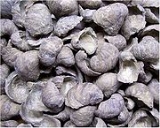
Pycnodonte
Encyclopedia
Pycnodonte is a genus
of extinct oyster
s, marine
bivalve mollusks in the family
Gryphaeidae
. They are found around the world in fossil
shell beds from the Valanginian
(140.2 Ma) to Early Pleistocene
(0.781 Ma). They are a commonly found fossil in Cretaceous
shellbeds of the Navesink Formation
in New Jersey
.
Genus
In biology, a genus is a low-level taxonomic rank used in the biological classification of living and fossil organisms, which is an example of definition by genus and differentia...
of extinct oyster
Oyster
The word oyster is used as a common name for a number of distinct groups of bivalve molluscs which live in marine or brackish habitats. The valves are highly calcified....
s, marine
Marine (ocean)
Marine is an umbrella term. As an adjective it is usually applicable to things relating to the sea or ocean, such as marine biology, marine ecology and marine geology...
bivalve mollusks in the family
Family (biology)
In biological classification, family is* a taxonomic rank. Other well-known ranks are life, domain, kingdom, phylum, class, order, genus, and species, with family fitting between order and genus. As for the other well-known ranks, there is the option of an immediately lower rank, indicated by the...
Gryphaeidae
Gryphaeidae
Gryphaeidae, common name the foam oysters or honeycomb oysters, is a family of marine bivalve mollusks, related to the true oysters.-Taxonomy:...
. They are found around the world in fossil
Fossil
Fossils are the preserved remains or traces of animals , plants, and other organisms from the remote past...
shell beds from the Valanginian
Valanginian
In the geologic timescale, the Valanginian is an age or stage of the Early or Lower Cretaceous. It spans between 140.2 ± 3.0 Ma and 136.4 ± 2.0 Ma...
(140.2 Ma) to Early Pleistocene
Early Pleistocene
Calabrian is a subdivision of the Pleistocene Epoch of the Geologic time scale. ~1.8 Ma.—781,000 years ago ± 5,000 years, a period of ~.The end of the stage is defined by the last magnetic pole reversal and plunge in to an ice age and global drying possibly colder and drier than the late Miocene ...
(0.781 Ma). They are a commonly found fossil in Cretaceous
Cretaceous
The Cretaceous , derived from the Latin "creta" , usually abbreviated K for its German translation Kreide , is a geologic period and system from circa to million years ago. In the geologic timescale, the Cretaceous follows the Jurassic period and is followed by the Paleogene period of the...
shellbeds of the Navesink Formation
Navesink Formation
The Navesink Formation is a 66 to 70 mya greensand glauconitic marl and sand geological formation in New Jersey. It is known for it its Cretaceous era fossil shell beds and dinosaur bones.-Description:...
in New Jersey
New Jersey
New Jersey is a state in the Northeastern and Middle Atlantic regions of the United States. , its population was 8,791,894. It is bordered on the north and east by the state of New York, on the southeast and south by the Atlantic Ocean, on the west by Pennsylvania and on the southwest by Delaware...
.
Species
- Pycnodonte callifera (Lamarck, 1819)
- Pycnodonte convexa
- Pycnodonte mutabilis
- Pycnodonte newberryiPycnodonte newberryiPycnodonte newberryi is a species in the Pycnodonte genus of extinct oysters, marine bivalve mollusks in the family Gryphaeidae. It lived from the Cretaceous period, 90 to 130 million years old. P. newberryi fossils generally exist in large layers or beds...
- Pycnodonte taniguchii

